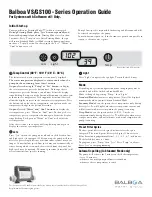
27
VMBME102
ROOM
If you wish to increase or reduce the indoor temperature, change the ROOM value. The difference between changing the ROOM value and
the CURVE value is that the system’s heat curve does not become steeper or flatter if the ROOM value is changed, which the curve becomes
if the CURVE value changes, instead the entire heat curve is moved by 3°C for every degree change of the ROOM value. The reason that the
curve is adjusted 3° is that an approximate 3° increase in supply temperature is needed to increase the indoor temperature 1°.
Figure 48: Changing the ROOM value changes the heat curve upwards or downwards.
The relationship of the supply temperature to outdoor temperature will not be affected. The supply temperature will be increased or
reduced by the same number of degrees all along the heat curve. I.E. the entire heat curve rises or drops instead of the curve gradient
changing.
This method of adjusting the indoor temperatures must only be used for a temporary raise or drop. For long term increases or reductions
of the indoor temperature, the heat curve is adjusted instead.
Sometimes, at outdoor temperatures between -5°C and +5°C, part of the heat curve may need adjusting if the indoor temperature is not
constant. For this reason, the control system includes a function adjusting the curve at three outdoor temperatures: -5°C, 0°C and +5°C. This
function will allow you to increase or reduce the supply temperature, without affecting the heat curve, at three specific outdoor temperatures.
If, for example, the outdoor temperature is -5°C, the supply temperature will change gradually between 0°C and -10°C, maximum adjustment
being reached at -5°C. The figure below shows the adjusted CURVE -5. The adjustment can be seen in the graph in the form of a bump.
Figure 49: The adjusted curve at -5°C
You can choose to adjust the heat curve individually at three specified outdoor temperatures: -5°C, 0°C and +5°C. The supply temperature
can be changed by plus/minus 5 degrees.
HEATSTOP
The HEATSTOP function automatically stops all production of radiator heat or under floor heating when the outdoor temperature is equal
to, or higher than, the value entered for heat stop.
When the heat stop function is activated, the circulation pump will be turned off - except when hot water is being produced. The circula-
tion pump will be "exercised" for 1 minute per day. The factory set value for activating heat stop is an outdoor temperature of 17°C. If the
heat stop function is active, the outdoor temperature must drop 3°C when setting, before the heat stop stops.
MIN and MAX
The MIN and MAX values are the lowest, respectively highest set point values that are allowed for the supply temperature.
Adjusting the minimum and maximum supply temperatures is particularly important if your home has under floor heating.
If your house has under floor heating and parquet floors, the supply temperature must not exceed 45°C. Otherwise there is a risk that the
parquet floors might be damaged If you have under floor heating and stone tiles, the MIN value should be 22-25°C, even in summer when
no heating is required. This is to achieve a comfortable floor temperature.
If your house has a basement, the MIN value should be adjusted to a suitable temperature for the basement in summer. A condition for
Supply temperature
Outdoor temperature
Maximum supply tem-
perature
Supply temperature
Outdoor temperature
Local higher supply tem-
perature at -5°
Содержание DHP-AL
Страница 1: ...VMBME102 Installation and service instructions DHP AL...
Страница 2: ......
Страница 4: ......
Страница 62: ...VMBME102...
















































